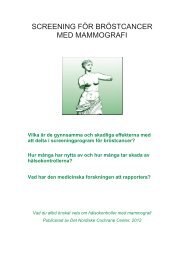1 Selective serotonin reuptake inhibitors (SSRI) â sales, withdrawal ...
1 Selective serotonin reuptake inhibitors (SSRI) â sales, withdrawal ...
1 Selective serotonin reuptake inhibitors (SSRI) â sales, withdrawal ...
You also want an ePaper? Increase the reach of your titles
YUMPU automatically turns print PDFs into web optimized ePapers that Google loves.
M. Nielsen and P. Gøtzsche / An analysis of psychotropic drug <strong>sales</strong> 131<br />
the treatment is not evidence-based. For example, escitalopram is almost 20 times more expensive than<br />
citalopram, even though the chemically active ingredient is the same.<br />
The change in treatment of anxiety disorder, from benzodiazepines to newer antidepressants, has<br />
happened despite a lack of evidence in support of this change, and marketing strategies could therefore<br />
have played an important role [14]. This change in prescription habits might have opened the market for<br />
new antidepressants.<br />
Guidelines have urged drug treatment of depression and anxiety [15, 16] and have emphasized the<br />
risks of under-treatment. They are often influenced by the companies’ marketing strategies and those<br />
who write them usually have numerous conflicts of interest in relation to receiving industry money [17].<br />
More than 60% of the doctors participating in the working group on the Danish depression guideline had<br />
financial ties to the pharmaceutical industry [15, 18].<br />
The prevalence of psychiatric disease and distress should also be interpreted in the light of changes in<br />
diagnostic and classification systems and a new symptom-based approach to substantiate the diagnosis<br />
as described in the Diagnostic, Statistical Manual of Mental Diseases III [19]. New disorders have been<br />
included and existing disorders ’exploded’, e.g. anxiety neurosis was split into seven new disorders [19].<br />
The symptom-based approach has been criticized for creating diseases, classifying normal life distress<br />
and sadness as mental disease that should be treated with drugs [19]. The symptoms described as criteria<br />
for depression are now broad, for example fatigue, insomnia or diminished ability to concentrate, and do<br />
not distinguish between a disorder and expected reactions to a situational context, for example the loss of<br />
a beloved person with symptoms persisting for more than two months [19]. Further other life crises like<br />
divorce, serious disease or loss of job are not mentioned as exclusion criteria [19]. Thus, it is likely that<br />
changes in the diagnostic classification systems have contributed to the increased <strong>sales</strong> of <strong>SSRI</strong>s, and that<br />
part of this increase represents over-diagnosis and over-treatment. This is further supported by the fact<br />
that 56% of the DSM IV overall panel members had financial ties to the pharmaceutical industry, and in<br />
the panel on “mood disorders”, 100% had such ties [20]. This indicates serious problems with conflicts<br />
of interests, not least because the ties were especially strong in those diagnostic areas where drugs are<br />
first line of treatment.<br />
5.1. Strengths and weaknesses<br />
We combined statistics from different time periods, based on varying ATC levels, which gave us the<br />
possibility to present data for usage at an overall level. The three different data sources all used ATC and<br />
DDD, and there are some overlaps between the data sources, which confirmed the reliability of the data.<br />
Data from the secondary sector are not included in the analysis, as prescription is low and therefore not<br />
important for the overall picture. Our data are on <strong>sales</strong>, which cannot be equated with usage. Another<br />
limitation is that the data were available as DDD, but the defined daily dose might be lower or higher<br />
than the average dose of a drug in practice. For example the DDD for citalopram is 20 mg [9] but the<br />
recommended dose varies between 10 mg and 60 mg [3].<br />
6. Conclusion<br />
The <strong>sales</strong> of psychotropic drugs has fluctuated widely over a 37-year period. We believe that the decline<br />
in <strong>sales</strong> of benzodiazepines was primarily due to the recognition that they cause serious dependency and<br />
by initiatives at a national level to curb their use, and that the recent steep increase in <strong>sales</strong> of <strong>SSRI</strong>s is a<br />
direct consequence of marketing pressures, as the effect of the <strong>SSRI</strong>s is overestimated [7, 8].





